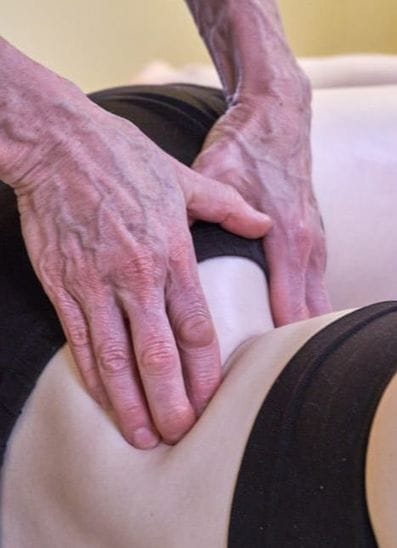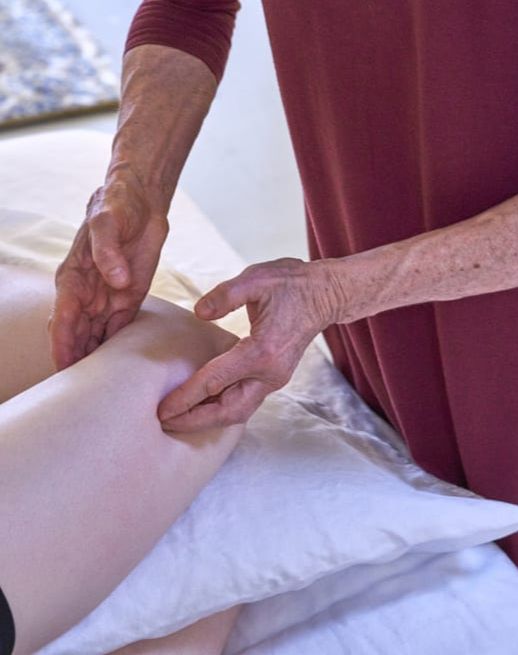What is Structural Integration?
Structural Integration is the name that Ida Rolf PhD gave to her system of bodywork designed to align the structures of the body with gravity. Her approach, commonly called “Rolfing,” focuses on manipulating the fascial system of the body. Fascia is the organ of shape. It is a continuous, three dimensional collagen matrix which surrounds every bone, muscle, muscle fiber, organ, vessel and nerve. Fascia is the environment which informs our tissues, similar to the paint which surrounds and qualifies every fiber of a paintbrush. It is its elasticity, or lack of such, that maintains the shape of our bodies, and our posture. When strained by trauma, injury or habit this fascia toughens and holds the body in less than optimal postures, ones that are taxing to the vitality and efficiency of the whole system. Dr. Rolf’s system is a ten session series of bodywork that unwraps the layers of the body to release postural distortions and then re-aligns the body’s segments to interact with each other in balanced harmony.
Ida Rolf was the originator of Structural Integration (SI.) Several of her graduates advanced her work and added to or altered some aspects of it, calling their work by these names: Hellerwork, Anatomy Trains Structural Integration, Soma, Zentherapy®, Structural Medicine and others. All of these types of bodywork apply a systematic approach to aligning structure, utilize a 10-12 session protocol similar to Rolfing, and fall under the category of Structural Integration.
Structural Integration is the name that Ida Rolf PhD gave to her system of bodywork designed to align the structures of the body with gravity. Her approach, commonly called “Rolfing,” focuses on manipulating the fascial system of the body. Fascia is the organ of shape. It is a continuous, three dimensional collagen matrix which surrounds every bone, muscle, muscle fiber, organ, vessel and nerve. Fascia is the environment which informs our tissues, similar to the paint which surrounds and qualifies every fiber of a paintbrush. It is its elasticity, or lack of such, that maintains the shape of our bodies, and our posture. When strained by trauma, injury or habit this fascia toughens and holds the body in less than optimal postures, ones that are taxing to the vitality and efficiency of the whole system. Dr. Rolf’s system is a ten session series of bodywork that unwraps the layers of the body to release postural distortions and then re-aligns the body’s segments to interact with each other in balanced harmony.
Ida Rolf was the originator of Structural Integration (SI.) Several of her graduates advanced her work and added to or altered some aspects of it, calling their work by these names: Hellerwork, Anatomy Trains Structural Integration, Soma, Zentherapy®, Structural Medicine and others. All of these types of bodywork apply a systematic approach to aligning structure, utilize a 10-12 session protocol similar to Rolfing, and fall under the category of Structural Integration.
|
What type of structural integration practitioner are you?
I became a certified Zentherapy® SI practitioner in 1986. A 10-session approach, The ‘Zen’ in Zentherapy® refers to early Rolfer William Leigh’s devotion to Zen Buddhism, and the influence of his Roshi’s teachings. Zentherapy’s® ideal is a practitioner with the clarity of a monk, and the sword like accuracy of a Samurai. Bodywork is no different (for client or practitioner) than the Zazen (meditation) cushion. (http://www.zentherapy.org/index.html) Certified in 2007 as an Anatomy Trains SI practitioner, I have been trained to utilize Tom Myers’ innovative and revolutionary Anatomy Trains principles in assessing, manipulating and integrating structure. Kinesis Myofascial Integration draws upon the influences of Ida Rolf and her 10-session series, furthering the work by adding the benefit of the ‘myofascial continuities’ perspective, and an extra two sessions; one to address rotations created by the ‘spiral line’ and one to better integrate the arms. (https://www.anatomytrains.com/) |
|
I have heard the sessions can be painful
Often the release of stuck or over-stressed fascia can be accompanied by mild to strong sensation. It can be described as heat, burning or the sensation of ‘already being bruised,’ as the fascia is stretched and freed. Pain is largely composed fear. Being afraid that one might feel pain causes a myriad of subtle guarding responses, thus making the practitioner’s touch feel more intense. The first thing we do when we are afraid is to hold our breath because fear commands, ”Freeze! You are in danger!” It is precisely this mistaken sense of danger while under the practitioner’s hands that makes pain so painful. It is a vicious cycle. Using your breath fully will allow you to stay aware of my hands and the letting go process. I recommend that you pay open attention to the actual quality of the sensation you experience while on the table without preconception that it is going to be intense. When you can pay attention in this way the fascia will actually change quite quickly and the unpleasant sensation will fade away as if by magic. Stay in communication with me about what you are feeling, so I can match you with care. Give me feedback so that my pressure keeps you in a manageable range. Trust yourself. Know that people don’t often engage something that they aren’t ready to process. |
|
The details
Your Structural Integration series will take 12 sessions to complete. It is recommended that you schedule a weekly session, so that you can experience the entire series as a coherent whole. Sessions may be scheduled further apart, but greatest benefit will result from once-a-week work. The sessions last an hour and a half to two hours at a rate of $160 per session. The length of the sessions is designed to allow time not only for hands-on bodywork, but also time for you to get up from the table, move around and feel the changes that are taking place, and for you and your practitioner to work with movement patterns, postural cueing and small bits of homework offered between sessions. Your alignment will be assessed in standing position at least once during each session, and you will be photographed before, during and after the series. Sometimes it takes time to get used to being studied visually, but know that it is only the relationship of your segments that is being scrutinized. You therefore will need to wear briefs during the bodywork (swimsuit or bra/panties for women, and briefs or shorts for men.) |
How do I know if this is right for me?
If you think you might be interested in an SI series but are not sure, I recommend booking the initial session, and you’ll have a much clearer idea of how we’ll work together and whether this is right for you.
To inquire about an appointment, click here or call 206.329.7046
If you think you might be interested in an SI series but are not sure, I recommend booking the initial session, and you’ll have a much clearer idea of how we’ll work together and whether this is right for you.
To inquire about an appointment, click here or call 206.329.7046
Proudly powered by Weebly




